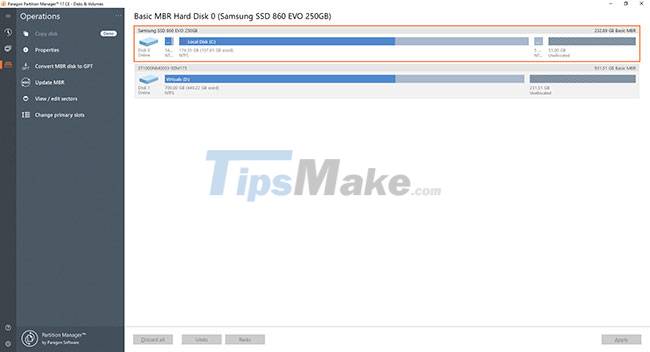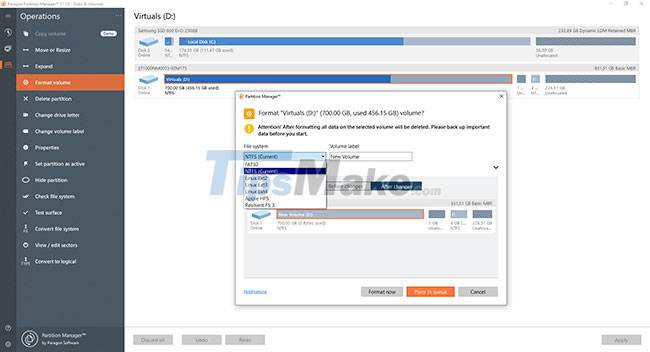Paragon Partition Manager - Download the latest Paragon Partition Manager
Paragon Partition Manager is a powerful, free software available only for Windows. Paragon Partition Manager makes it easy to create, resize, reformat, and delete hard drive partitions. However, it is more suitable for casual users, as advanced users may need more control over the algorithms that this software allows.
Download the latest Paragon Partition Manager here.

Features of Paragon Partition Manager
Resize and move partitions
Adjust the partition size by sliding the partition left and right, or enter the exact partition size you want.
Recover deleted partitions
You can recover your volume and data if you accidentally delete the wrong partition
Create and delete partitions
Format your HDD, SSD, USB, memory card, SD card or delete a partition so that the device can be reused
Extend partitions
Redistribute free space using unallocated and open space on contiguous volumes.

Change the label
Change partition labels or drive letters to improve data organization
Error checking
Check for errors on selected partitions and fix them.
Convert drives or partitions
- Convert a logical partition to a primary partition and vice versa
- Convert HFS volume to NTFS without reformatting
- Convert MBR to GPT drive and vice versa
System Requirements

- Supported operating systems: Windows 7 SP1 and above
- Supported bus interfaces:
- Parallel ATA (Parallel Advanced Technology Attachment)
- SATA (Serial Advanced Technology Attachment)
- External SATA (eSATA)
- All levels of SCSI, IDE and SATA RAID controllers
- SCSI (Small Computer System Interface)
- USB (Universal Serial Bus) 1.x/2.0/3.0
- IEEE 1394 (FireWire)
- All types of RAID (hardware and software)
- PC or PCMCIA Card (Personal Computer Memory Card International Association)
- Supported Memory
- AFD (Advanced Format Drive)
- Sector size drive is not 512B
- SSDs and HDDs
- All common optical drive devices
- Supported file systems
- Backup Capsule (View Only)
- NTFS (v1.2, v3.0, v3.1)
- FAT32
- Ext2, 3, 4
- ReiserFS (v. 1, 2. View only. All other operations in 1:1 mode)
- Linux Swap
- HPFS (View only. All other operations in 1:1 mode)
- Apple HFS+
- B-tree FS (Btrfs)
- Extents FS (XFS)
- Hardware requirements
- Intel Pentium CPU or equivalent, with processor clock speed of 1000 Mhz
- 1GB+ RAM
- Internet Explorer 10 or later
- Hard drive with 250MB of free space
- SVGA monitor and video adapter
- Opened ports in Firewall: inbound and outbound 80, 443
- WinPE-based recovery CD
You should read it
- Paragon reduced the price of computer data protection software
- Partitioning for the hard drive
- 10 free partitioning tools
- EASEUS Partition Master - Download the latest EASEUS Partition Master
- Free use of Paragon Drive Copy 11 Compact program
- This is how to delete Recovery partition and Recovery partition 450 MB on Windows 10
- Remove 'reserve system' partition in Windows 7
- Instructions to divide and merge drives right in Windows 7
- Top 10 free Windows partition management software
- 4 ways to quickly check the partition type on Windows 11
- 3 ways to hide recovery partition (Recovery) on Windows 10 / 8.1 / 7
- What is the Master Partition Table?
May be interested

Instructions to livestream playing games on Nonolive using PC

EASEUS Partition Master - Download the latest EASEUS Partition Master

TOP 5 best free antivirus software in 2022, effective and convenient

EasyBCD - Download the latest EasyBCD

DevToys - a great set of utilities for Windows developers

Choosing A User Behavioral Analytics Software






 Paragon reduced the price of computer data protection software
Paragon reduced the price of computer data protection software EASEUS Partition Master - Download the latest EASEUS Partition Master
EASEUS Partition Master - Download the latest EASEUS Partition Master Partitioning for the hard drive
Partitioning for the hard drive 10 free partitioning tools
10 free partitioning tools Neat Download Manager 1.3/1.8.0, download Neat Download Manager 1.3/1.8.0 here
Neat Download Manager 1.3/1.8.0, download Neat Download Manager 1.3/1.8.0 here Link Internet Download Manager 6.38-build-1
Link Internet Download Manager 6.38-build-1